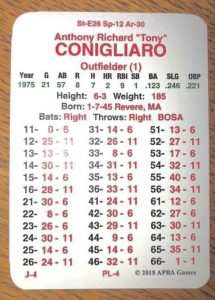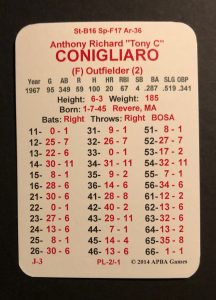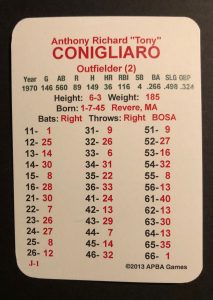
Tony Conigliaro was the Bryce Harper of the 1960s.
When Jack Hamilton died in February, baseball saw the conclusion to one of its most tragic events. On August 18, 1967, a Hamilton fastball struck Tony Conigliaro on his left cheek, dislocating his jaw, damaging his left retina, and fracturing his cheekbone. Conigliaro would miss the rest of the 1967 season, including the World Series, and the entire 1968 campaign. Though Tony C made a courageous comeback in 1969 and had an excellent season in 1970, the effects of his beaning would end his career prematurely.
Tony Conigliaro burst on the scene in 1964 as a slugging, 19-year old outfielder for the Boston Red Sox. His 24 homers his rookie season are still the most ever hit by a teenage player. The next season at age 20, the slugging prodigy hit 32 dingers, becoming the youngest player to lead the American League in home runs.

After a solid 1966 campaign, Conigliaro looked to be coming into his own in 1967. Tony C played 95 games before his tragic injury and was hitting .287 with 20 homers and 67 RBI. He represented the Red Sox in the All-Star Game for the only time in his career, and undoubtedly would have made a difference for Boston in their seven game defeat to the St. Louis Cardinals in the World Series.

After missing the entire 1968 season, Conigliaro made a triumphant comeback in 1969. For the year, he hit .255 with 20 homers and 82 RBI. Then came 1970, which was probably Tony C’s finest season. That season saw Tony hit .266 with a career high 36 home runs and 116 RBI. Conig’s big season prompted the Red Sox to trade him to the California Angels in October, 1970. Tony started suffering from the effects of his beaning in 1971 and only played in 74 games for the Angels. Eventually the Angels released him at the end of the 1974 season.
| Split | G | GS | PA | AB | R | H | 2B | 3B | HR | RBI | SB | BB | SO | BA | OBP | SLG | OPS | TB | SF |
|---|---|---|---|---|---|---|---|---|---|---|---|---|---|---|---|---|---|---|---|
| 1975 Totals | 21 | 15 | 69 | 57 | 8 | 7 | 1 | 0 | 2 | 9 | 1 | 8 | 9 | .123 | .221 | .246 | .466 | 14 | 3 |
The Boston Red Sox re-signed Tony Conigliaro in the spring of 1975. He played in 21 games for Boston but only hit .123. In September, he was released and never played in the Big Leagues again. He was only 30 years old. APBA was kind with this card. I project it to produce a .137 average. At least Tony C ended his APBA days with a 66-1. It seems fitting. There are a few quirks to this card. First it only has one 9 (standard is 2) and two 8s (standard is 3). Second, it has a 55-40. Finally, it’s got a 15-14 and a 25-14.
In 1982, Conigliaro suffered a heart attack and then a stroke and spent the last eight years of his life in a vegetative state. He died in 1990 at only 45 years of age. After reaching heights players could only dream about, his life took a tragic turn when he was only twenty-two. Unfortunately, the courage Tony displayed in his playing comeback and retirement was cut tragically short. If Conigliaro would have had normal longevity, it’s easy to see him hitting 500+ home runs and making the Baseball Hall of Fame. Unfortunately, his career was over by the time he was 26, and he missed out on two opportunities to play in the World Series. As we approach the new year, the moral of Tony Conigliaro’s story hits home: Be thankful for what you have because you never know when things might change.




Great recap, Kevin!
I was familiar with Tony’s incident but had no idea that it was Jack Hamilton who threw the ball. Hamilton pitches for the Mets in my 1966 replay, albeit very poorly (3-11, 6.22 ERA).
I also did not realize Tony C played as late as 1975. This is definitely a case of “what could have been?”. If he had gone on to play as a healthy OF, he could have affected the Boston organization for the next decade.
thanks again!
Tom
So horribly sad.